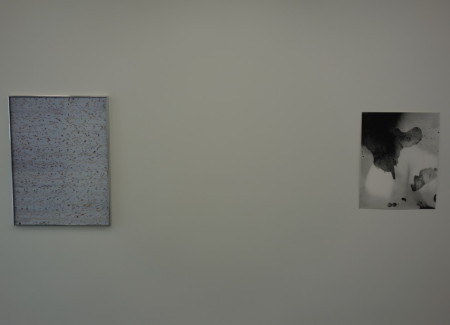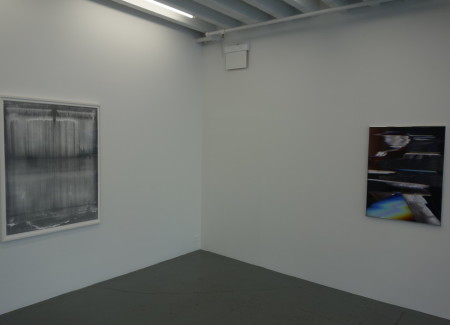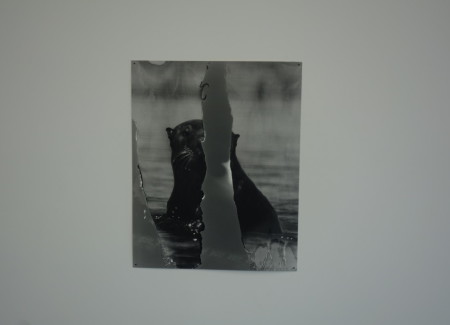JTF (just the facts): A total of 25 color and black and white photographs, framed in silver and unmatted or pinned directly to the wall, and hung against white walls in the two main gallery spaces and the entrance and back hallways at 88 Eldridge Street and against white/black walls in the main gallery space at 36 Orchard Street. The 17 black and white works on view are gelatin silver prints, made in 2015 or 2016. These prints are sized between 25×20 and 51×40 (or reverse), and are available in editions of 3+2AP. The 9 color images (including 1 diptych) are digital chromogenic prints (some mounted to Dibond), made in 2011 and 2015. These prints are sized between 40×30 and 60×48 (or reverse), and are also available in editions of 3+2AP. The show also includes a work made of quilted vinyl (2016, roughly 82×66) and an array of 12 mirrors (each 40×30). (Installation shots below.)
Comments/Context: Eileen Quinlan’s sprawling new show is like an overstuffed buffet of photographic manipulation and degradation. Spanning analog and digital, chemical and physical, it has the appearance of a restless sampler of experimentation and boundary testing, where one approach leads to the next in a methodical test-all-the-combinations progression. Seen together, it reads like a process-centric search for technical limits and edges, trying to ascertain the location of that elusive point where legible representation breaks down and abstraction takes over.
Mirrors bookend this two-venue exhibit, providing starting and end points to Quinlan’s investigations. The earliest image on view (from 2011) uses mirrors conventionally, to break up and reassemble a colorful geometric quilt from multiple perspectives, in an otherwise straight photograph. A floor-to-ceiling array of mirrors installed in the smaller Orchard Street space offers a more conceptual twist, reflecting both the gallery space and a glitched digital abstraction, fragmenting them both into a grid of tiles. The reflected image (and several more like it on view back in the Eldridge Street spaces) is actually built on a double dose of mirrors, as it uses a mirror to reflect the light from a scanner back into its own receptors, creating cameraless smears of wavy digital light, like rainbow feedback or ghostly visual echoes. Named after video games, these works are reflections of the digital realm, or perhaps better, photographs of refracted nothing.
In between, Quinlan relies primarily on chemical decay to upend the underlying imagery, from eroded and peeled emulsions that seem to open up endless voids to washes and spots of splattered drippy fluids that turn images into splotchy waves and painterly pulled lines. These techniques are applied to a variety of pictures, and this is where things get complicated. There are black and white images of dense tree landscapes and forest animals taken by Quinlan, as well as flash lit nude selfies of the artist in the shower (some distorted by body parts being pushed up against the glass door). There are also appropriated images of landscapes, the ancient ruins at Palmyria, and a shattered restaurant window in post-attack Paris, which have been rephotographed and further twisted and manipulated before being subjected to additional chemical treatments. Along the way, authorship and process get muddy, and a few iterative analog/digital hybrids make the situation even less clear. A cut up and rewoven blue plastic wading pool brings the manipulation conversation full circle, back to the resolutely physical, the classical motif on the bottom of the pool interlaced and undermined just like the fluted columns in the nearby photographs.
The challenge with this show is that this taxonomy of tests and trials offers few concrete conclusions – it shows us all the intermediate experiments without moving on to narrowing down the approaches that work best and expanding on the learnings that created them. Quinlan is perhaps a decade behind others who have pushed scanners to their limits, her sinuous glitches no more innovative than those of many who came before. And her spectrum of underlying subject matter, with its intentional variations of sourcing, doesn’t lead to a coherent conclusion about where to go next – degradations and creative destruction can thoughtfully inform many interchangeable themes and motifs. Which I think leaves us largely where we started, with the knowledge that there is an expansive menu of ways to disassemble a photograph, especially when it can oscillate between a physical presence and a screen-based relative.
Quinlan is successfully showing us the meticulousness and robustness of her thinking here, making an effective proof of all the available options. But in the end, these paired exhibits feel transitional, like hubs with tracks leading in all directions. Perhaps her next show will provide us the synthesized results of all this smart investigative testing, and some initial evidence of a tangible commitment to move down one path and dig in deeper.
Collector’s POV: The works in this show range in price from $8000 to $20000 based on size. Quinlan’s work has just begun to trickle into the secondary markets, with recent prices ranging from roughly $3000 to $15000.





















